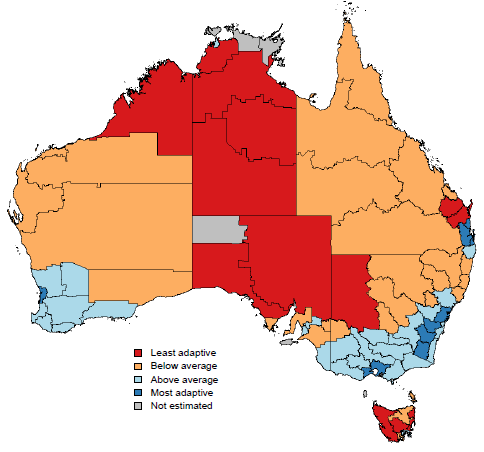Regional adaptive capacity – reviewing the 2017 Productivity Commission Study Report
I have been looking into the impact of regions across Australia, which I briefly touched on yesterday. I recently came across the Australian Government’s December 2017 Productivity Commission Study Report: Transitioning Regional Economies.
As I come to the end of the thesis, it is one of those documents that you think “Why did I not find you sooner?” Thankfully, much of the thought process in the report is reflected in my thesis and visa versa.
Below are some highlights:
Defining resilience
There are multiple perspectives on the concept of economic resilience. Literature generally refers to three approaches:
- The capacity to return to the previous state (engineering);
- The capacity to shift between states (equilibrium, panarchy); and
- The capacity to adapt to continuous change (transformative, adaptive).
This is a crude summary, but contemporary thinking is that we live in an environment of constant change and regions need capability and capacity to transform and adapt.
The diagram below from the report is a helpful depiction:

The report favours the term adaptive capacity for this reason:
Resilience is seen in the outcomes realised by individuals (including workers, business owners and operators, and families). Being resilient might involve, for instance, moving across regions to take up new opportunities. Adaptive capacity, on the other hand, involves the factors that shape whether individuals have the means to take up new opportunities, within and between regions.

The report goes on to describe “relative adaptive capacity”:
Relative adaptive capacity is an unobservable attribute of a region. It is not a measure of resilience to disruptive events. Rather, it is a summary of the complex set of factors affecting resilience, including the skills and education of regional workforces, access to infrastructure and services, availability of natural resources, financial resources available to businesses and individuals, and industry diversity.
An index of adaptive capacity
The report provided an index of adaptive capacity for regions – a single number to compare and provide guidance on ways to improve a region’s economic and community status. This index is made up of 45 indicators across six dimensions: Human capital; Financial capital; Physical capital; Natural capital; Social capital; and Other.
I appreciate the effort that goes into such a review. For my own thesis I explored ten different models in an attempt to aggregate before I came across the assessment by Sharfi (2016) who analysed 36 different frameworks to create a list of 125 indicators.
The Productive Commission report applied their index to 89 regions across Australia. Applying a single number as a score can be a challenge and has high variability. This is acknowledged in the figure below which shows significant variance. In some instances, changing just one or two variables can shift a region from least adaptive to most adaptive.

Some generalities can be made, however and the application across the nation is as expected. Remote regions trend towards lower adaptive capacity due to population, industry, and access to resources.

The generalities are outlined in the figure below. Regions that have lower populations are less adaptive and more at risk to shocks.

Reflection in the current context
The report provides findings, recommendations, and strategies which you can review in more detail. I may consolidate these in a future post.
My own particular focus is on the role that innovation plays in supporting community resilience / adaptive capacity. This is important but seems minor in light of the current situation in Australia. There are structural factors that contribute to lower adaptive capacities in areas outside of metro regions.
These factors will be highlighted more than ever with the current fires across Australia. The majority of the regions being impacted are the ones who were already most at risk. For many towns, it will be a matter of not just adapting but of rebuilding.
The task then becomes how adaptive capacity can be integrated into the support and policies across Australia over the next 12 months.

